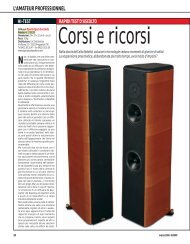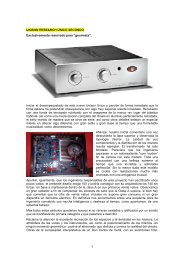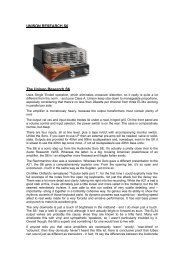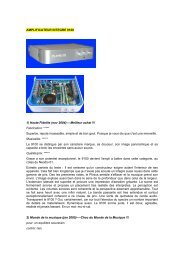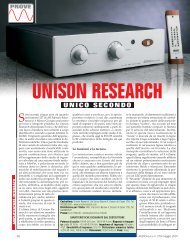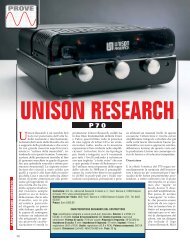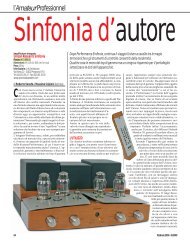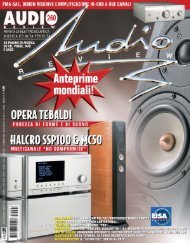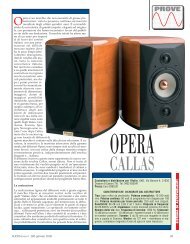Unison Research S6 Integrated Amplifier - Lyric Audio Elite
Unison Research S6 Integrated Amplifier - Lyric Audio Elite
Unison Research S6 Integrated Amplifier - Lyric Audio Elite
Create successful ePaper yourself
Turn your PDF publications into a flip-book with our unique Google optimized e-Paper software.
<strong>Unison</strong> <strong>Research</strong> <strong>S6</strong> <strong>Integrated</strong> <strong>Amplifier</strong>It is not uncommon for the audiophile tokeep a cherished component when, in atemporary lapse of judgment, thatcomponent is superseded in their systemby the latest and greatest. Or perhaps anunneeded but long-coveted or "classic"piece might become available at the rightprice. What, then, to do with thesuperfluous gear? Well, if you’re anythinglike me, you build a second system. Withtime, second systems themselvesbecome susceptible to upgrading. Giventime enough and money, one can end upwith a system in each room of the house.The fun never ends!By the nature of their provenance, secondary systems tend to be simpler than their primarycounterparts. While the main system may serve as a vehicle for endless tweaking and analyticallistening, the second system’s usual function is to simply make music. As the second system istypically housed in a multifunctional space, domestic acceptance is a prime consideration.Which brings me to the <strong>Unison</strong> <strong>Research</strong> <strong>S6</strong>, an Italian-made, integrated tube amplifier that hasbeen at the heart of my second system for the past six months.<strong>Unison</strong> <strong>Research</strong>, along with its sister company, Opera Loudspeakers, is headquartered innorthern Italy as Advanced <strong>Research</strong> In <strong>Audio</strong> (A.R.I.A.). <strong>Unison</strong> is perhaps best known onthese shores for their Unico hybrid integrated amplifier, widely regarded as offering tremendousvalue. The Unico line has been expanded to include a number of sleek-looking electronics(including a CD player and tuner), most of which incorporate tubes somewhere along the signalpath. But the company’s foundation was built on pure tube electronics, which they havemanufactured since 1987. Presently, <strong>Unison</strong> offers consumers ample choice, producingamplifier models based on the KT88, EL34, and 845 output tubes in a variety of differentconfigurations.The <strong>S6</strong> integrated ($2995 USD) uses three Electro Harmonix EL34 power tubes per channel.Operating in class-A, single-ended mode, the output stage produces a robust 35Wpc. <strong>Unison</strong>engineers have applied 14dB of negative feedback to produce what they feel is optimal sound.The preamplifier stage uses one 12AU7 (Philips JAN 5814As are supplied) per channel. Foursingle-ended, line-level inputs are available, and a tape loop is accessible via a toggle switch onthe front panel.When I unpacked the <strong>S6</strong>, the first thing I noticed was that it is considerably deeper than it iswide. Its rubber footers measure some 14" front to back, barely allowing the amp to sit level ona standard-sized shelf in an old Target rack. The <strong>S6</strong> is also surprisingly hefty: 56.2 pounds,most of that weight in the rear, where reside the beefy output and power transformers. Inaddition to the inputs, the rear panel sports high-quality, insulated speaker binding posts withprovision for output impedances of 4 and 8 ohms. A 15A IEC power-cord socket lies beneaththe power switch at the back. The front panel is dominated by two large, finely machined,stainless-steel knobs for volume control and source selection.A hallmark of the <strong>Unison</strong> aesthetic is the use of wood accents. Although the <strong>S6</strong> is the least"woodsy" of the line, the incorporation of a small cherrywood insert at the front cornertransforms the design from just another black box into living-room furniture. Well, almost. The<strong>S6</strong> is also unique in that it is the only <strong>Unison</strong> amp that comes with an integral tube cage. This is
an attractive, hinged, chrome affair that I have yet to determine how to remove completely. Apalm-sized, wooden remote control has but two buttons, for increasing and decreasing thevolume. As the remote functions via radio frequency, it is nondirectional and can be operated atlong range and through the walls of adjoining rooms.SystemThe <strong>S6</strong> is plug-and-play easy, with no manual tube biasing necessary. I placed it on the livingroomfloor and connected it to two Sonus Faber Guarneri Homage speakers via 6m ofconcealed Nordost Flatline Gold Mk.II speaker cable from the <strong>S6</strong>’s 4-ohm outputs. The sourcewas <strong>Unison</strong>’s own Unico CD player, via Cardas Hexlink 5 interconnect. After some 20 hours ofburn-in, the <strong>S6</strong> was ready to show its stuff.SoundThe <strong>S6</strong> produced a full-bodied, voluptuous sound in a front-hall perspective that I never feltsounded too forward. It was a midrange champ, rendering the voices of my usual suspects,such as Holly Cole and Diana Krall, with tremendous texture and presence. Well-produced,older recordings were also presented wonderfully. A case in point was Ella Fitzgerald’s Fine andMellow [CD, Pablo 2310-829], which richly captures her fully matured pipes running the gamutfrom coo to growl while swinging all the way. This Grammy-winning album is basically a jamsession featuring Ella and notable sidemen Zoot Sims, Clark Terry, and Harry Edison, amongothers. Individual instruments were precisely placed on a generous soundstage. I sometimesuse "The Man I Love" to assess pace, rhythm, and timing, as the tune builds to a climax -- the<strong>S6</strong> did not disappoint.Brass and woodwinds were presented with vivid tonal colors. While definitely playing to thewarmer side of neutral when compared to my reference Nagra VPA tube monoblocks, the <strong>S6</strong>was not really euphonic in the way of, say, a Conrad-Johnson MV-50, the only other EL34-based amp I recall having had in-house -- some 20 years ago. As one might surmise, thissystem reproduced strings beautifully. Jordi Savall’s soundtrack for the film Tous les Matins duMonde [CD, Auvidis/Travelling K 4640] features 17th-century French music for the bass viol(viola da gamba). The sound of the solo viol is haunting, and the <strong>Unison</strong> reproduced theinstrument’s sonorous harmonic overtones, as well as the recording acoustic, in breathtakingfashion. Detail freaks will revel in listening to Savall’s stertorous breathing as he vigorouslyapplies bow to strings.Rachel Podger’s reading of Vivaldi’s La Stravaganza [CD, Channel Classics CCS SA 19503] isanother disc that has been in heavy rotation of late. Massed strings had the appropriate bite andsheen, but never sounded strident in this wonderfully energetic performance. Severalmovements (e.g., the Allegro from the A-minor concerto) lend themselves to high-volumelistening; the <strong>Unison</strong> handled the ebb and flow of this highly dynamic material with aplomb,showing no sign of strain, at least when paired with the 88dB-sensitive, 8-ohm-nominalimpedanceSonus Faber Guarneris.Although the expectation of a magical midrange was fulfilled, other attributes of the <strong>S6</strong> came asmore of a surprise. By a significant margin, its bass output was subjectively fuller and moreextended than that produced by the Krell KAV-300R receiver, which preceded the <strong>Unison</strong> in thissystem. While the bass may not have been as taut as that produced by the little Krell, it wasclearly more tuneful and articulate, which went a long way in helping to convey the rhythm andtiming of music. On the Bill Charlap Trio’s All Through the Night [CD, Criss 1153 CD], PeterWashington’s bass lines on the title track induced involuntary head-bobbing and foot-tapping,while Charlap’s forcefully struck piano notes were presented with attack and decaycharacteristics not unlike those of the real thing. Similarly, highs were naturally extended andairy, with no sense of treble rolloff.The <strong>S6</strong> sounded considerably more ballsy than its 35Wpc rating would suggest. Nevertheless,on complex orchestral material such as the opening Invocation, from Prokofiev’s Scythian Suite[CD, Mercury Living Presence 432 753-2], the music can appear a touch confused and lessresolute than when played back on my reference system. In fact, I inserted the <strong>S6</strong> into the mainrig to see how it would fare driving the Wilson <strong>Audio</strong> Sophias. It performed admirably indeed,yielding the same grainless purity of sound as it did with the Guarneris. There was a little less
clarity of detail and some limitation in macrodynamics when compared to the CAT Ultimatepreamp and Nagra VPA monoblocks I usually use here, but as this combination costs morethan eight times as much as the <strong>S6</strong>, the comparison was not completely fair. What wasimpressive was that the <strong>S6</strong>’s basic musicality shone through. System matching is important;while the Sophias’ full potential was clearly not realized with the <strong>Unison</strong>, it is hard to imagine abetter mate for the Sonus Faber Guarneris, with which I preferred the sound of the <strong>Unison</strong> overthat of the much costlier Nagras.Some listening was done with my long-term reference digital source, the Sony SCD-1 SACD/CDplayer and an old Rotel RCD-955AX, the latter taking pride of place in my wife’s office system.The <strong>S6</strong>’s performance characteristics remained consistent regardless of the source, but realsynergy was apparent when it was used with the Unico CD.I picked some tiny nits. The <strong>S6</strong> ran extremely warm; placement on a top shelf or floor ismandatory. The location of the main power switch at the rear corner is awkward; again,attention to placement and dressing of speaker cables is necessary for ease of access.Although I felt no need for a subwoofer in my system, a subwoofer output might be useful forsome.ConclusionIn the <strong>S6</strong>, the folks at <strong>Unison</strong> <strong>Research</strong> have succeeded in engineering a product that displaysall the musicality of tubes with none of the traditional drawbacks, such as flabby bass orattenuated highs. The fit’n’finish is top-notch, and my unit has operated flawlessly now for sixmonths. Current-production replacement tubes are readily available and relatively inexpensive -- the <strong>S6</strong> would be an ideal amp for the tube-phobic who have relatively efficient speakers and apenchant for smaller-scale acoustic music. Nor will the <strong>S6</strong> disappoint tube aficionados, whocould probably reach into their stashes of arcane NOS tubes to further fine-tune its sound.Most of all, the <strong>Unison</strong> <strong>S6</strong> is suited to music lovers, irrespective of technological bent. Will italter my decades-old, bank-account-draining habit of equipment swapping and tweaking?Probably not, as that’s what I like to do. But were I to be banished to the proverbial desertisland, I’d make sure to take the <strong>Unison</strong> <strong>S6</strong> out of the second system and bring it along with me.Ken Choi ULTRA <strong>Audio</strong> (November 2004)



